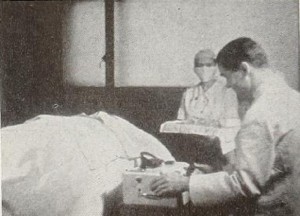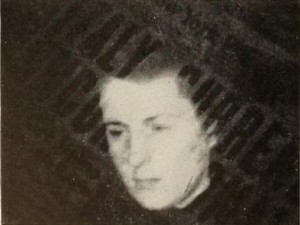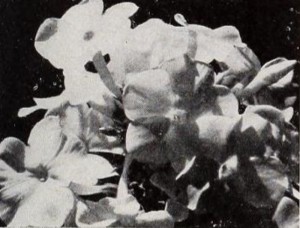
"We have seen many medical and surgical films made by Dr. Robert Mallory, III, and most of them have been excellent. This one, however, a picturization of an extremely delicate operation on the eye, surpasses them all. It is a suave and exact record of the complete operation, featuring splendid full frame closeups of the eyeball. The exposure and filming technique are flawless except for one or two scenes in slightly soft focus. We are well aware of the difficulties encountered in making a film of this kind, and we feel that Dr. Mallory has scored a distinct triumph here. He is an exceptionally neat worker, and the entire film shows the effects of care in production and editing. Movie makers who have aspirations to become filmers of medical or surgical material could well take this film for a pattern." Movie Makers, Dec. 1942, 508.
"A couple dine in a restaurant. She is so busy with powdering her nose and correcting her lipstick that the "garçon" despairs of ever getting their order. In the end, her suitor orders water and razor to get his revenge." Library and Archives Canada.
"The story concerns a girl who, during her husband’s absence in the East, takes a lover. The husband returns home unexpectedly, and, in a heated scene, threatens the lover with an automatic. Unfortunately for him this expansive gesture is witnessed by a tramp. The tramp thinks he had better retreat. As he hurries from the scene he hears a shot ring out and returns to find that the lover has been killed. He reports to a policeman, with the result that the husband is arrested, tried, and condemned to death. Dramatic Climax - With feminine perversity the wife now realises that it is her husband who she really loves, and implores her sister’s fiancé, a member of the C.I.D., to save her husband, whom she believes innocent. He promises to do his best, and, on fuller investigation, finds a sodden letter near the spot where the murder was committed. On making enquiries he finds that a man has recently been lodging at the address given on the envelope, who had just returned from America, and had disappeared on the day of the murder. When finally arrested the man tells of a private vendetta with the lover and of his determination to be avenged. A witness to the quarrel, he shoots the erstwhile friend just after the quarrel with the husband. The final scenes lend themselves to a thrilling climax. The final shot portrays the face of the murderer as he discharges his gun point blank at the audience" (M.A.L.B. 1931: 6).

"Return from Fire, as defined by its producer, Dr. W. Lynwood Heaver, is the "biography of a mental breakdown." In its opening we meet a boy and girl idyllically in love. But the clouds of war fall across their summer sunshine, the young man is called up and, in a short time, is announced as missing in combat. It is then that the fires of apprehension, misery and terror sear into the girl's mind. How modern psychiatry serves, at last, to recall her from this self inflicted limbo is the climactic denouement of Dr. Heaver's drama. The conception of Return from Fire is imaginative and exciting. The acting and its correlative direction are excellent throughout. A provocative musical score contributes markedly to the maintenance of dramatic tension. Dr. Heaver's camera work, rising occasionally to heights of cinematic imagination, is sound, satisfying and suggestive of still greater things to come. Put down his name as one to watch!" Movie Makers, Dec. 1945, 494.
"The theme, a slight and amusing one, concerned itself with the difficulties of a non-teetotal couple on a visit to their aunt, an elderly and confirmed total abstainer. The photography, especially the daylight interiors, is particularly good" (HMHT 1933: 370&374)

"Revelation indeed reveals the slow, but intense, life of flowers as they unfold. Hans J. Theiler, who built a special mechanism for the purpose, has made time lapse studies of blooms in their determined efforts to find sunlight. Other flowers lose as well as open. The time lapse sequences are preceded by closeup footage of various blooms impeccably filmed. In the chief section of the picture, Mr. Theiler has caught very dextrously the unusual and almost terrifying performances of plants as they carry on their exceedingly active careers. The time lapses are exceptionally smooth." Movie Makers, Dec. 1944, 496.
"A man is shot, the gun is handed to an innocent lad who is promptly grabbed by a police officer. Rex Malloy is asked to defend the young man. Money is available to Rex if he will not defend the boy. Rex is much concerned, money vs. professional conscience. In a moment of sleep, head on hands on the desk, his subconscious finds a way to remind him of his duty" PSA Journal, Nov. 1960, 42.
"A black-and-white silent animation, which Kaneko himself described as a visualization of a musical score, Hungarian Rhapsodie. He experimented with visual geometric abstraction as a means to express the musical score, and this film was his first attempt to use the koma-otoshi technique (the technique being used for time-lapse photography or stop-motion animation)." - Noriko Morisue, "Filming the Everyday: History, Theory, and Aesthetics of Amateur Cinema in Interwar and Wartime Japan" (Yale University: PhD Dissertation, 2020): 99.
Total Pages: 299